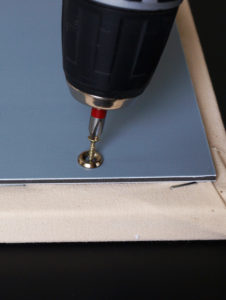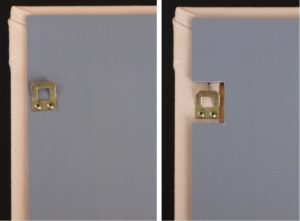Backing boards are simple and wonderfully effective at protecting the condition of paintings. They are standard in painting conservation and have proven to significantly reduce visible aging. Installing backing boards can easily be done by artists themselves. Their benefits are many:
- Protection to impact damage from behind (tear, puncture, deformation). This is not just for the rare case that a painting falls against a table edge, for instance, but for the many times when paintings are moved around in tight studio spaces and something ends up touching the canvas from the reverse.
- Finger poking is another common form of mechanical damage, which might not show right away but can cause stresses in the canvas, ground and paint layers, which could show further down the line. With a backing board, there is simply no chance of sticking fingers in-between the stretcher and canvas when carrying paintings.
- Reduces the accumulation of dust, wall debris, insects, etc.
- Buffers fluctuations in humidity and temperature (day-night cycles & wall-room temperature differences), which reduces the risk of cracking paint layers. Recommendations for the type of backing board vary, depending on the overall local climate. More details below in Humidity and Ventilation.
- Reduces shocks and vibrations, especially in large paintings, which tend to ‘flag’ or bounce back and forth while being transported. When paintings are dropped, backing boards (particularly when attached to the stretchers) significantly reduce paint cracking. More on vibrations and backing boards below in Paintings in Transit.
There is a wide range of practices when it comes to the exact material, form, and attachment method for backing boards. What follows are a couple of simple options that artists can use to protect their own works. What should be stressed is that, although backing boards can provide significant protection, they are not a magical fix and careful handling, good storage and routine check-ups are still recommended.
Materials for Backing Boards
Many different materials can be used for backing boards. They should be lightweight, sturdy and resistant to degradation. Foam boards, corrugated plastic sheeting, mounting boards, honeycomb and archival corrugated cardboard can all be used, although, cardboard might attract cellulose eating insects like silverfish, especially in humid environments. Composite materials such as Dibond®, acrylic or polycarbonate sheets are heavier but can provide additional structural support, if needed.
Attaching Backing Boards
Backing boards can be attached directly to the back of a stretcher or frame. Screws are more elegant, stable and practical than staples, because fewer of them are needed and they make removing and reusing backing boards easier. Stiching awls or similar pins can be used to perforate the board. This helps to place and attach the screws (Image 1). Since most backing boards are made from relatively soft materials, it helps to use screw washers, so that the screws do not push through the board (Image 2). For large paintings, two or more individual boards can be used and attached to stretcher cross bars. With screw washers two boards can be affixed a the same time (Image 3).



Hangers can be attached on top of backing boards, but cutting out holes for the hanging systems is possible too (Image 4).

Some stretchers have stepped profiles with a groove cut into the inner edge. This makes it easy to accommodate a backing board without increasing the depth of the painting and making it stand out further from the wall, which some artists might dislike. Particularly, stretchers with T-profiles and some Heavy-Duty stretchers have stepped profiles (Image 5). Examples would be the Creative Mark Probar Stretchers, the Heavy Duty stretchers by John Annesley Company, and stretchers from Jack Richeson & Co., as well as Upper Canada Stretchers. When using regular stretchers, one can mill a 3 mm deep and about 5 mm wide recess into the reverse of a stretcher to fit in a backing board.

Humidity and Ventilation
The exact shape and ideal material for backing boards depends mostly on the environmental conditions of the space where the painting will live.
In cold climates the dry air of heated rooms is problematic. Low humidity causes increased tension and stiffening in ground and paint layers, while canvases relax. Therefore, it is important to seal the backing board well to keep the dry air out from behind the painting. The Canadian Institute for Conservation recommends using foam strips in between stretcher bars and the backing board to prevent air gaps (well sealed backing boards also create a better air cushion and thus dampening effect during travel).
In humid climates mold growth is the biggest concern. Relative humidity over 65% becomes risky.

Usually, air is more humid during the night than it is during the day. Even if the humidity rises way above 65% at night, that can be okay, as long as the space behind a painting can dry during the day, so that mold cannot grow. To allow the moisture to escape, backing boards must have sufficiently big ventilation holes. Cutting off the corners of a backing board is an easy way to provide ventilation (Image 6). Screens can be placed over the vent holes to keep insects and dirt out, or, in very humid climates, rigid backing boards can be replaced altogether with screens.
In temperate climates a wide range of practices are common and possible (cut corners/fully covering boards/type of material), although, humidity and mold still have to be considered. House walls, especially masonry walls, or shaded walls, tend to be cooler than the respective room temperatures. This leads to a more humid environment directly behind a painting. Backing boards help to insulate the cooler wall temperatures and thus can prevent mold growth.
Paintings in Transit
Transporting paintings on bumpy roads exposes them to damaging shock and vibration. Now, each material vibrates at its own frequency when exposed to certain movement. When backing boards create a resonance vibration with a painting, more, rather than less flapping of the canvas may be the result. It was found that thinner backing board materials (tested were 3 mm corrugated cardboard, polyurethane hard foam core board, and polycarbonate multiwall board) tend to increase vibrations at typical truck-transportation frequencies, while more sturdy corrugated cardboard (4.5 mm and better yet 8 mm), as well as honeycomb cardboard significantly dampen the vibrations of paintings (see http://www.gemaeldetransport.ch/kti/wp-content/uploads/2011/11/Baeschlin_ICOM-CC_2011.pdf).
This is relevant to know for those who care for paintings which travel a lot. The vast majority of paintings out there, however, remain where they are or travel only a few times during their lifetimes. For those stay-home paintings, backing boards do a lot to conserve their condition, regardless of the inherent so called eigenfrequency (natural frequency of a system) of the backing materials during transit.
As usual, for questions feel free to reach out to [email protected] or [email protected] or use our contact forms: https://www.goldenpaints.com/product_support.
About Mirjam Auf der Mauer
View all posts by Mirjam Auf der Mauer -->Subscribe
Subscribe to the newsletter today!
No related Post

Since we don’t know where collectors live or will live and what environment the paintings will be displayed in, it doesn’t appear to be a good idea to attach a backing board and doing so may create problems.
Hallo Valerie,
Thank you for your comment. We would never advice artists to do something with their works that they are not comfortable with. If you were curious about the effect of backing boards you could test it by hanging a set of trial paintings with and without backing boards in your house, studio, garage or garden shed. Somewhere where it will not be in the way for some years… As said in the article backing boards have proven many times to help conserve the condition of paintings and are a standard in conservation nowadays. If the final location of a painting was unknown, then a backing board from corrugated plastic or foam board (some material particularly resistant to degradation) with ventilation holes in the corners, should be a safe choice. More literature on the subject can be found in the following links:
• https://www.canada.ca/en/conservation-institute/services/conservation-preservation-publications/canadian-conservation-institute-notes/backing-boards-paintings.html
• https://www.conservation-wiki.com/wiki/Backing_Boards
• https://books.google.de/books?id=1msM3h9mbaoC&pg=PA729&lpg=PA729&dq=conservation+of+easel+paintings+backing+boards&source=bl&ots=UOkAfYP9kg&sig=ACfU3U1UVzgZfwiWs1HZCgHX2Q3-xRfptQ&hl=en&sa=X&ved=2ahUKEwie8ejO89zjAhVOZ1AKHSmeAKMQ6AEwFHoECAkQAQ#v=onepage&q=%20backing%20boards&f=false
Nice to know I haven’t been going wrong with the use of corrugated plastic board.
One option I’ve seen used by framers is to put a viewing widow of stiff transparent plastic (mylar?) in the backing-board. So that a signature signed on the reverse of the canvas is still visible.
Hi Marc,
thank you for mentioning viewing holes. They are indeed a great and wonderfully simple way to make signatures visible.
I never knew I could use foam board. I always used brown paper. Is the board I buy at WalMart or any hobby store okay to use or are Golden’s boards the only ones that will stand up to this? Thanks for the great tip!
Hello Lynn,
thank you for your comment. Golden does not make any boards and we also have not tested different brands. I am not familiar with the foam boards from Wallmart, but would think that they are not archival and might need to be exchanged after a couple of years. There is also the aspect of pH. However, the foam boards from Walmart are probably not more acidic than brown paper. Better would be foamcore boards with acid free paper or plastic coatings. Fome-Cor® Acid Free or Coroplast® Archival grade are relatively inexpensive options.
I’m considering using Mod Podge to adhere a finished piece of artwork on watercolor paper to backing board. I want to create an open frame for a couple of pieces and need a suitable substrate to mount them on. Would a backing board be durable enough for this purpose? Thank you!
Hello Valerie, it depends on your archival demands on your support. A wooden panel would be more durable than foamboard or cardboard, but for short or mid-term, the latter materials would do. Most frames come with a thin MDF board, which would provide additional support.